Kingdom Animalia Order Squamata Genus Varanus Rank Species | Phylum Chordata Family Varanidae Scientific name Varanus salvator Higher classification Monitor lizard | |
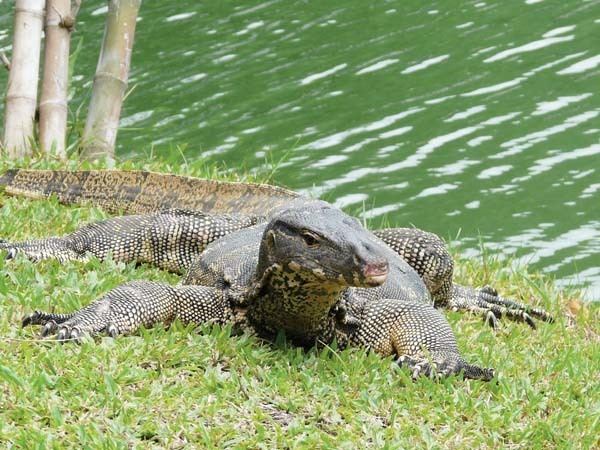 | ||
Similar Monitor lizard, Bengal monitor, Reptile, Savannah monitor, Nile monitor | ||
Asian water monitor care tips reptiles magazine
Varanus salvator, commonly known as the water monitor, is a large lizard native to South and Southeast Asia. Water monitors are one of the most common monitor lizards found throughout Asia, and range from Sri Lanka and India to Indochina, the Malay Peninsula, and various islands of Indonesia, living in areas close to water.
Contents
- Asian water monitor care tips reptiles magazine
- Sri lanka ceylon varanus salvator asian water monitor lizard reptile
- Description
- Etymology
- Subspecies
- Behavior and diet
- Conservation
- References
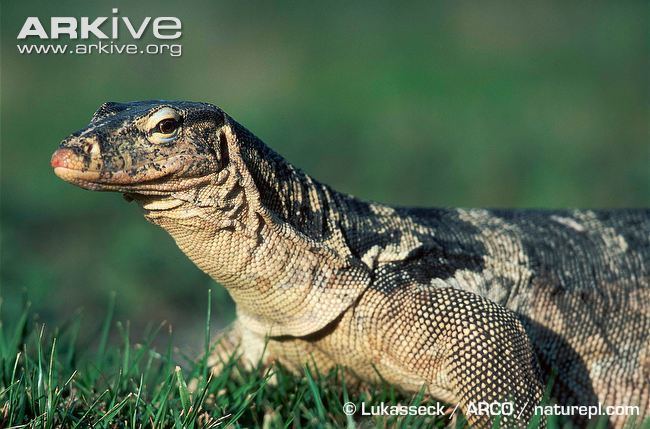
The species is known as Malayan water monitor, Asian water monitor, common water monitor, two-banded monitor, and as rice lizard, ring lizard, plain lizard and no-mark lizard, as well as simply "water monitor".
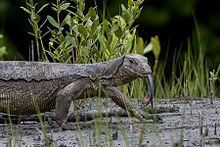
Sri lanka ceylon varanus salvator asian water monitor lizard reptile
Description

The water monitor is a large species of monitor lizard. Breeding maturity is attained for males when they are a relatively modest 40 cm (16 in) long and weigh 1 kg (2.2 lb), and for females at 50 cm (20 in). However, they grow much larger throughout life, with males being larger than females. Adults rarely exceed 1.5–2 m (4.9–6.6 ft) in length, but the largest specimen on record, from Sri Lanka, measured 3.21 m (10.5 ft). A common mature weight of V. salvator can be 19.5 kg (43 lb). However, 80 males killed for the leather trade in Sumatra averaged only 3.42 kg (7.5 lb) and 56.6 cm (22.3 in) snout-to-vent and 142 cm (56 in) in total length; 42 females averaged only 3.52 kg (7.8 lb) and 59 cm (23 in) snout-to-vent and 149.6 cm (58.9 in) in total length, although unskinned outsized specimens weighed 16 to 20 kg (35 to 44 lb). Another study from the same area by the same authors similarly estimated mean body mass for mature specimens at 20 kg (44 lb) while yet another study found a series of adults to weigh 7.6 kg (17 lb). The maximum weight of the species is over 50 kg (110 lb). In exceptional cases, the species has been reported to attain 75 to 90 kg (165 to 198 lb), though most such reports are unverified and may be unreliable. They are the world's second-heaviest lizard, after the Komodo dragon. Their bodies are muscular, with long, powerful, laterally compressed tails.
Etymology
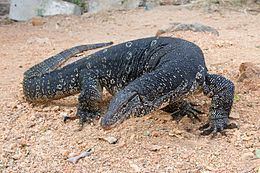
The generic name Varanus is derived from the Arabic waral (ورل), which translates as "monitor". The specific name is the Latin word for "saviour", denoting a possible religious connotation. The water monitor is occasionally confused with the crocodile monitor (V. salvadorii) because of their similar scientific names.
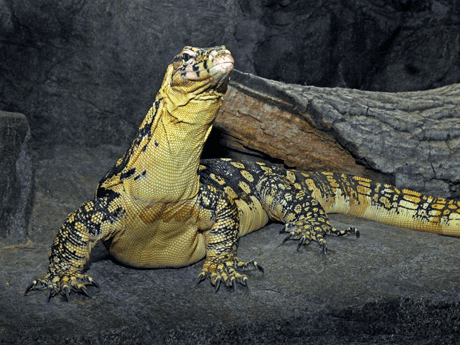
In Thailand, the local word for a water monitor, hia (เหี้ย), is used as an insulting word for bad and evil things, including bad persons. The word is also thought to bring bad luck, so some people prefer to call the animals 'silver-and-gold' (ตัวเงินตัวทอง) to avoid the jinx.
The origin of this offensive meaning can be traced back to a time when more people lived in rural areas in close proximity to monitor lizards. Traditionally, Thai villagers lived in two-story houses; the top floor was for living, while the ground floor was designed to be a space for domestic animals such as pigs, chickens, and dogs. Water monitors would enter the ground floor and eat or maim the domestic animals, also hence the other name dtua gin gai (ตัวกินไก่ ‘chicken eater’).
In Indonesian and Malay, the water monitor is called biawak air, to differentiate it from the biawak pasir ("sand lizard"), Leiolepis belliana.
Subspecies
Behavior and diet
Water monitors defend themselves using their tails, claws, and jaws. They are excellent swimmers, using the raised fin on their tails to steer through water. They are carnivores, and consume a wide range of prey. They are known to eat fish, frogs, rodents, birds, crabs, and snakes. They have also been known to eat turtles, as well as young crocodiles and crocodile eggs. Like the Komodo dragon, they will often eat carrion. Water monitors have been observed eating catfish in a fashion similar to a mammalian carnivore, tearing off chunks of meat with their sharp teeth while holding it with their front legs and then separating different parts of the fish for sequential consumption.
Conservation
Monitor lizards are traded globally and are the most common lizard to be exported from Southeast Asia, with 8.1 million exported between 1998 and 2007. Water monitors are used by humans for a variety of purposes and are one of the most exploited varanids. They are hunted predominantly for their skins for use in fashion accessories such as shoes, belts and handbags which are shipped globally, with as many as 1.5 million skins traded annually. Other uses include as a perceived remedy for common skin ailments and eczema, a perceived aphrodisiaca, novelty food in Indonesia and as pets.
In Nepal's Chitwan National Park it is a protected species under the Wild Animals Protection Act of 2002. In Hong Kong, it is a protected species under Wild Animals Protection Ordinance Cap 170. In Malaysia, this species is one of the most common wild animals, with numbers comparable to the population of macaques there. Although many fall victim to humans via roadkill and animal cruelty, they still thrive in most states of Malaysia, especially in the shrubs of the east coast states such as Pahang and Terengganu. In Thailand, all monitor lizards are protected species. They are still very common in large urban areas in Thailand and are frequently seen in Bangkok canals and parks.
Loss of habitat and hunting has exterminated water monitors from most of mainland India. In other areas they survive despite being hunted, due in part to the fact that larger ones, including large females that breed large numbers of eggs, have tough skins that are not desirable.
In Sri Lanka, they are protected by locals who value their predation of "crabs that would otherwise undermine the banks of rice fields".
